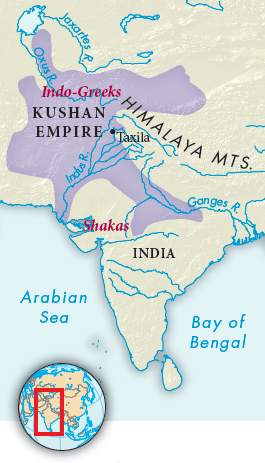Understanding World Societies:
Printed Page 83
> How was India shaped by political disunity and contacts with other cultures during the five centuries from 185 B.C.E. to 300 C.E.?
AAfter the Mauryan Dynasty collapsed in 185 B.C.E., and for much of subsequent Indian history, political unity would be the exception rather than the rule. By this time, however, key elements of Indian culture — the caste system; the religious traditions of Hinduism, Buddhism, and Jainism; and the great epics and legends — had given India a cultural unity strong enough to endure even without political unity.

In the years after the fall of the Mauryan Dynasty, a series of foreign powers dominated the Indus Valley and adjoining regions. The first were hybrid Indo-
The great, slow movement of nomadic peoples out of East Asia that brought the Scythians to the Near East brought the Shakas to northwest India. They controlled the region from about 94 B.C.E. to 20 B.C.E., when they were displaced by a new nomadic invader, the Kushans, who ruled the region of today’s Afghanistan, Pakistan, and west India as far south as Gujarat.
During the Kushan period, Greek culture had a considerable impact on Indian art. Indo-
Cultural exchange also went in the other direction. Old Indian animal folktales were translated into Syriac and Greek and these translated versions eventually made their way to Europe. South India in this period was also the center of active seaborne trade, with networks reaching all the way to Rome. Indian sailing technology was highly advanced, and much of this trade was in the hands of Indian merchants. In the first century C.E. a Greek merchant involved in this trade reported that the traders sold coins, topaz, coral, crude glass, copper, tin, and lead and bought pearls, ivory, silk (probably originally from China), jewels of many sorts (probably many from Southeast Asia), and above all cinnamon and pepper.
During these centuries there were significant advances in science, mathematics, and philosophy. Indian astronomers charted the movements of stars and planets and recognized that the earth was spherical. In the realm of physics, Indian scientists, like their Greek counterparts, conceived of matter in terms of five elements: earth, air, fire, water, and ether. This was also the period when Indian law was codified. The Code of Manu, which lays down family, caste, and commercial law, was compiled in the second or third century C.E., drawing on older texts.
Regional cultures tend to flourish when there is no dominant unifying state, and the Tamils of south India were one of the major beneficiaries of the collapse of the Mauryan Dynasty. The period from 200 B.C.E. to 200 C.E. is considered the classical period of Tamil culture, when many great works of literature were written under the patronage of the regional kings. Some of the poems written then provide evidence of lively commerce, mentioning bulging warehouses, ships from many lands, and complex import-
>QUICK REVIEW
What impact did the Kushans have on Indian society and culture?